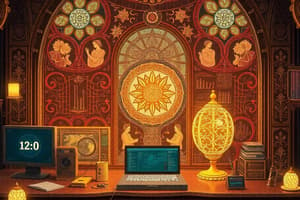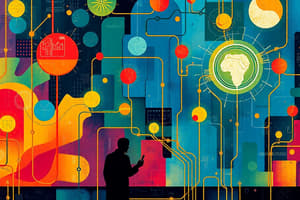Podcast
Questions and Answers
The Information Age is characterized by unprecedented access to ______.
The Information Age is characterized by unprecedented access to ______.
information
Catalysts for change in the Information Age include low-cost computers and high-speed ______.
Catalysts for change in the Information Age include low-cost computers and high-speed ______.
communication networks
New technologies such as smartphones and video streaming ______ continue to emerge.
New technologies such as smartphones and video streaming ______ continue to emerge.
services
Self-driving cars are one of the exciting advancements in the ______.
Self-driving cars are one of the exciting advancements in the ______.
The Samsung Galaxy S9 Plus is a product that functions as a phone, text messenger, email client, and ______.
The Samsung Galaxy S9 Plus is a product that functions as a phone, text messenger, email client, and ______.
Voice-activated digital assistants are examples of ______ technologies.
Voice-activated digital assistants are examples of ______ technologies.
Low-cost ______ have contributed significantly to the advancements in the Information Age.
Low-cost ______ have contributed significantly to the advancements in the Information Age.
High-speed communication networks enable quicker access to ______.
High-speed communication networks enable quicker access to ______.
In the year 1950, only a handful of electronic digital ______ existed.
In the year 1950, only a handful of electronic digital ______ existed.
Today, we are surrounded by networked devices containing embedded ______.
Today, we are surrounded by networked devices containing embedded ______.
Getting information from technology can cause the release of ______ in the brain.
Getting information from technology can cause the release of ______ in the brain.
The advent of automobiles provided greater ______ but also led to traffic jams.
The advent of automobiles provided greater ______ but also led to traffic jams.
Modern web technologies support ______ retrieval tools.
Modern web technologies support ______ retrieval tools.
The cash register was a response to the problems of keeping accurate sales records and preventing ______.
The cash register was a response to the problems of keeping accurate sales records and preventing ______.
In the late 19th century, punched cards were used for ______ processing systems.
In the late 19th century, punched cards were used for ______ processing systems.
The first commercial computer, U N I V A C, was delivered to the U.S. Bureau of the ______.
The first commercial computer, U N I V A C, was delivered to the U.S. Bureau of the ______.
I B M's expansion in Germany in the 1930s saw it engage with the Nazi ______.
I B M's expansion in Germany in the 1930s saw it engage with the Nazi ______.
The E N I A C was one of the earliest computers that had its program stored in ______.
The E N I A C was one of the earliest computers that had its program stored in ______.
Google's search engine uses a system known as ______ to measure the importance and quality of web pages.
Google's search engine uses a system known as ______ to measure the importance and quality of web pages.
Cloud storage simplifies accessing files from multiple ______.
Cloud storage simplifies accessing files from multiple ______.
Information technology devices include tablets, smartphones, and ______.
Information technology devices include tablets, smartphones, and ______.
The convenience of credit cards increases the possibility of ______.
The convenience of credit cards increases the possibility of ______.
The rise of social media creates a potential conduit for ______ ideas.
The rise of social media creates a potential conduit for ______ ideas.
The first higher-level programming language designed for scientific applications is ______.
The first higher-level programming language designed for scientific applications is ______.
The ______ is a computer inside a semiconductor chip invented in 1970 at Intel.
The ______ is a computer inside a semiconductor chip invented in 1970 at Intel.
The ______ allowed multiple users to connect to a computer via terminals.
The ______ allowed multiple users to connect to a computer via terminals.
The technology that replaced vacuum tubes and was invented at Bell Labs is called a ______.
The technology that replaced vacuum tubes and was invented at Bell Labs is called a ______.
The ______ is a standardized programming language designed for business applications.
The ______ is a standardized programming language designed for business applications.
In the early days of computing, the ______ was used to educate people on how to use computers.
In the early days of computing, the ______ was used to educate people on how to use computers.
The invention of the integrated circuit at Fairchild Semiconductor and Texas Instruments led to components that were ______.
The invention of the integrated circuit at Fairchild Semiconductor and Texas Instruments led to components that were ______.
The ______ was the first line funded by the U.S. government to connect Washington, D.C. to Baltimore.
The ______ was the first line funded by the U.S. government to connect Washington, D.C. to Baltimore.
Alexander Graham Bell is known for constructing the first ______.
Alexander Graham Bell is known for constructing the first ______.
The ______ created by Gates and Allen helped popularize personal computing.
The ______ created by Gates and Allen helped popularize personal computing.
Tomlinson wrote software to send, receive ______ messages.
Tomlinson wrote software to send, receive ______ messages.
The Internet uses the ______ protocol for communication.
The Internet uses the ______ protocol for communication.
Broadband connections make it feasible to transfer very large ______.
Broadband connections make it feasible to transfer very large ______.
The first cell phone appeared in ______.
The first cell phone appeared in ______.
Cloud computing allows utilization of remote computing resources over the ______.
Cloud computing allows utilization of remote computing resources over the ______.
The first true alphabet with 24 characters was developed by the ______.
The first true alphabet with 24 characters was developed by the ______.
Gutenberg's printing press was based on movable ______ type.
Gutenberg's printing press was based on movable ______ type.
Vannevar Bush envisioned a device called ______.
Vannevar Bush envisioned a device called ______.
The first widely used web browser was called ______.
The first widely used web browser was called ______.
Wi-Fi is the most common ______ technology.
Wi-Fi is the most common ______ technology.
Flashcards are hidden until you start studying
Study Notes
Introduction to the Information Age
- Characterized by unprecedented access to information due to low-cost computers and high-speed networks.
- Emerging technologies impact everyday life, including smartphones and self-driving cars.
Milestones in Computing
- Aids to Manual Calculating:
- Tools have evolved from ancient clay tablets to mechanical calculators like the Arithmometer and Scheutzes' printing calculator.
- Social Change and Market for Calculators:
- Industrialization in the Gilded Age created demands for efficient bookkeeping tools, leading to the widespread adoption of calculators.
- Cash Registers:
- Developed in response to department stores' needs to maintain accurate sales records and prevent theft.
- Punched Card Tabulation:
- Introduced in the late 19th century, revolutionizing data processing for organizations like the U.S. Bureau of the Census.
Impact of Early Computing
- I.B.M. and World Events:
- I.B.M. played a controversial role during the Holocaust by aiding the Nazi regime in census efforts.
- First Commercial Computers:
- The UNIVAC propelled the computing industry forward, predicting the 1952 Presidential election results.
Development of Programming Languages
- Higher-Level Languages:
- Assembly language and FORTRAN facilitated complex program creation, followed by COBOL for business applications.
- Time-Sharing Systems:
- Enabled multiple users to access mainframe computers simultaneously, making computing more accessible.
Evolution of Hardware
- Transistors:
- Invented in 1948, these replaced vacuum tubes, leading to smaller, more reliable computers.
- Integrated Circuits:
- Combined multiple components into a single chip, enhancing speed and reducing costs.
The Rise of Personal Computing
- Microprocessors:
- Invented in 1970, these made personal computers feasible, catalyzing a computing revolution.
- Notable Computers:
- The Altair 8800 and the Apple I drove home computer popularity in the late 1970s.
Networking Milestones
- Telegraph and Telephone:
- The telegraph revolutionized communication in the 19th century, while the telephone blurred lines between public and private lives.
- ARPANET:
- Established by the Department of Defense, it laid the groundwork for the modern Internet with decentralized communication and packet-switching technology.
Internet Development
- Creation of E-Mail:
- Developed by Tomlinson, it became a vital communication tool alongside the growth of networking technologies.
- Google and Search Engines:
- Revolutionized information retrieval on the Internet, utilizing PageRank for better search results.
Storage and Retrieval Innovations
- Transition from Oral to Written Culture:
- Greek alphabet development represented a shift in information recording, allowing for efficient written communication.
- Gutenberg's Printing Press:
- Mass-produced texts, facilitating widespread literacy and the spread of ideas, particularly during the Reformation.
The Cloud Computing Era
- Cloud Technology:
- Enables remote data storage and access over the Internet, supporting flexible and scalable computing solutions like those from AWS and Microsoft Azure.
Information Technology Issues
- Copyright Piracy:
- The ease of digital duplication spurred illegal downloading, with significant impact on media industries.
- Cloud Storage Security:
- Raises questions about data safety and ownership, especially regarding personal information and financial transactions.### Loan Applications
- Evaluate credit history instead of conducting personal interviews for approval.
- Offer lower interest rates, but with reduced flexibility for borrowers.
Computers in Embedded Devices
- Liability concerns arise when embedded systems fail and cause harm to humans.
Telecommuting
- Enables time-saving and flexible work hours for employees.
- Raises questions about whether teleworkers are disadvantaged regarding promotions.
Global Communication Network
- Facilitates companies' ability to sell products worldwide.
- Companies can relocate jobs outside of the U.S. as a result of enhanced connectivity.
- Ethical considerations about work conditions in factories in developing countries.
Social Media
- Acts as a platform for democratic ideas and discourse.
- Can be exploited by totalitarian regimes as a tool for control and propaganda.
Information Age Overview
- Current era known as the Information Age, marked by the transformation of technology.
- Modern devices result from centuries of technological advancements.
- Social dynamics drive the emergence of new technologies and their adoption can reshape society.
- Computing professionals hold a responsibility to thoughtfully contribute to future technological developments.
Studying That Suits You
Use AI to generate personalized quizzes and flashcards to suit your learning preferences.




